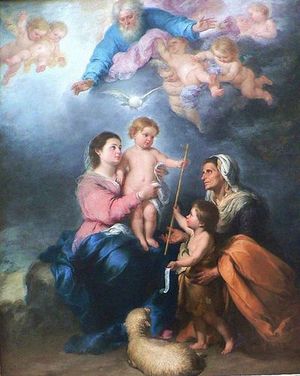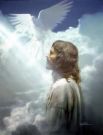Symbols of the Holy Spirit
According to the CATECHISM of the Catholic Church
- When the Master sent out the twelve two by two, among other acts they “cast out many devils, and anointed with oil many that were sick, and healed them” (Mark 6:13).
The Symbols of the Holy Spirit are:
694 Water. The symbolism of water signifies the Holy Spirit's action in Baptism, since after the invocation of the Holy Spirit it becomes the efficacious sacramental sign of new birth: just as the gestation of our first birth took place in water, so the water of Baptism truly signifies that our birth into the divine life is given to us in the Holy Spirit. As "by one Spirit we were all baptized," so we are also "made to drink of one Spirit."27 Thus the Spirit is also personally the living water welling up from Christ crucified28 as its source and welling up in us to eternal life.29
695 Anointing. The symbolism of anointing with oil also signifies the Holy Spirit,30 to the point of becoming a synonym for the Holy Spirit. In Christian initiation, anointing is the sacramental sign of Confirmation, called "chrismation" in the Churches of the East. Its full force can be grasped only in relation to the primary anointing accomplished by the Holy Spirit, that of Jesus. Christ (in Hebrew "messiah") means the one "anointed" by God's Spirit. There were several anointed ones of the Lord in the Old Covenant, pre-eminently King David.31 But Jesus is God's Anointed in a unique way: the humanity the Son assumed was entirely anointed by the Holy Spirit. The Holy Spirit established him as "Christ."32 The Virgin Mary conceived Christ by the Holy Spirit who, through the angel, proclaimed him the Christ at his birth, and prompted Simeon to come to the temple to see the Christ of the Lord.33 The Spirit filled Christ and the power of the Spirit went out from him in his acts of healing and of saving.34 Finally, it was the Spirit who raised Jesus from the dead.35 Now, fully established as "Christ" in his humanity victorious over death, Jesus pours out the Holy Spirit abundantly until "the saints" constitute - in their union with the humanity of the Son of God - that perfect man "to the measure of the stature of the fullness of Christ":36 "the whole Christ," in St. Augustine's expression.
696 Fire. While water signifies birth and the fruitfulness of life given in the Holy Spirit, fire symbolizes the transforming energy of the Holy Spirit's actions. The prayer of the prophet Elijah, who "arose like fire" and whose "word burned like a torch," brought down fire from heaven on the sacrifice on Mount Carmel.37 This event was a "figure" of the fire of the Holy Spirit, who transforms what he touches. John the Baptist, who goes "before [the Lord] in the spirit and power of Elijah," proclaims Christ as the one who "will baptize you with the Holy Spirit and with fire."38 Jesus will say of the Spirit: "I came to cast fire upon the earth; and would that it were already kindled!"39 In the form of tongues "as of fire," the Holy Spirit rests on the disciples on the morning of Pentecost and fills them with himself40 The spiritual tradition has retained this symbolism of fire as one of the most expressive images of the Holy Spirit's actions.41 "Do not quench the Spirit."42
697 Cloud and light. These two images occur together in the manifestations of the Holy Spirit. In the theophanies of the Old Testament, the cloud, now obscure, now luminous, reveals the living and saving God, while veiling the transcendence of his glory - with Moses on Mount Sinai,43 at the tent of meeting,44 and during the wandering in the desert,45 and with Solomon at the dedication of the Temple.46 In the Holy Spirit, Christ fulfills these figures. The Spirit comes upon the Virgin Mary and "overshadows" her, so that she might conceive and give birth to Jesus.47 On the mountain of Transfiguration, the Spirit in the "cloud came and overshadowed" Jesus, Moses and Elijah, Peter, James and John, and "a voice came out of the cloud, saying, 'This is my Son, my Chosen; listen to him!'"48 Finally, the cloud took Jesus out of the sight of the disciples on the day of his ascension and will reveal him as Son of man in glory on the day of his final coming.49
698 The seal is a symbol close to that of anointing. "The Father has set his seal" on Christ and also seals us in him.50 Because this seal indicates the indelible effect of the anointing with the Holy Spirit in the sacraments of Baptism, Confirmation, and Holy Orders, the image of the seal (sphragis) has been used in some theological traditions to express the indelible "character" imprinted by these three unrepeatable sacraments.
699 The hand. Jesus heals the sick and blesses little children by laying hands on them.51 In his name the apostles will do the same.52 Even more pointedly, it is by the Apostles' imposition of hands that the Holy Spirit is given.53 The Letter to the Hebrews lists the imposition of hands among the "fundamental elements" of its teaching.54 The Church has kept this sign of the all-powerful outpouring of the Holy Spirit in its sacramental epicleses.
700 The finger. "It is by the finger of God that [Jesus] cast out demons."55 If God's law was written on tablets of stone "by the finger of God," then the "letter from Christ" entrusted to the care of the apostles, is written "with the Spirit of the living God, not on tablets of stone, but on tablets of human hearts."56 The hymn Veni Creator Spiritus invokes the Holy Spirit as the "finger of the Father's right hand."57
701 The dove. At the end of the flood, whose symbolism refers to Baptism, a dove released by Noah returns with a fresh olive-tree branch in its beak as a sign that the earth was again habitable.58 When Christ comes up from the water of his baptism, the Holy Spirit, in the form of a dove, comes down upon him and remains with him.59 The Spirit comes down and remains in the purified hearts of the baptized. In certain churches, the Eucharist is reserved in a metal receptacle in the form of a dove (columbarium) suspended above the altar. Christian iconography traditionally uses a dove to suggest the Spirit.[1]

see above
27 1 Cor 12:13.
28 Jn 19:34; 1 Jn 5:8.
29 Cf. Jn 4:10-14; 738; Ex 17:1-6; Isa 55:1; Zech 14:8; 1 Cor 10:4; Rev 21:6; 22:17.
30 Cf. 1 Jn 2:20:27; 2 Cor 1:21.
31 Cf. Ex 30:22-32; 1 Sam 16:13.
32 Cf. Lk 418-19; Isa 61:1.
33 Cf. Lk 2:11,26-27.
34 Cf. Lk 4:1; 6:19; 8:46.
35 Cf. Rom 1:4; 8:11.
36 Eph 4:13; cf. Acts 2:36.
37 Sir 48:1; cf. 1 Kings 18:38-39.
38 Lk 1:17; 3:16.
39 Lk 12:49.
40 Acts 2:3-4.
41 Cf. St. John of the Cross, The Living Flame of Love, in The Collected Works of St. John of the Cross, tr. K. Kavanaugh, OCD, and O. Rodriguez, OCD (Washington DC: Institute of Carmelite Studies, 1979), 577 ff.
42 1 Thess 5:1.
43 Cf. Ex 24:15-18.
44 Cf. Ex 33:9-10.
45 Cf. Ex 40:36-38; 1 Cor 10:1-2.
46 Cf. 1 Kings 8:10-12.
47 Lk 1:35.
48 Lk 9:34-35.
49 Cf. Acts 1:9; cf. Lk 21:27.
50 Jn 6:27; cf. 2 Cor 1:22; Eph 1:13; 4:3.
51 Cf. Mk 6:5; 8:23; 10:16.
52 Cf. Mk 16:18; Acts 5:12; 14:3.
53 Cf. Acts 8:17-19; 13:3; 19:6.
54 Cf. Heb 6:2.
55 Lk 11:20.
56 Ex 31:18; 2 Cor 3:3.
57 LH, Easter Season after Ascension, Hymn at Vespers: digitus paternae dexterae.
58 Cf. Gen 8:8-12.
59 Cf. Mt 3:16 and parallels.
See also

External links
- Symbols of the Holy Spirit
- Holy Ghost Catholic Encyclopedia.
References
- ↑ Symbols of the Holy Spirit CATECHISM OF THE CATHOLIC CHURCH.




